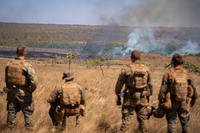Halting the flow of illegal drugs into the country can seem like a daunting task. However, vigilant Coast Guard crews are undeterred, meeting the challenges of drug interdiction head on. In California, their efforts are paying off. The Coast Guard recently surpassed a 50-ton milestone for marijuana seized at sea off the California coast this fiscal year.
“I’m very proud of the work being done by interdiction crews from the Coast Guard and all the agencies involved,” said Rear Adm. Karl Schultz, 11th Coast Guard District commander. “In addition to the harmful societal effects of the illicit drugs being delivered to our shores, and the extreme violence of the drug trafficking organizations in the source countries, these high-speed smuggling boats in our coastal waters pose a threat to the environment and other mariners. We appreciate reports and tips about suspicious vessels from the boaters and coastal residents to help stem the flow of smuggling.”
There has been a dramatic increase in maritime smuggling over the past few years off of California. Illicit drugs from the U.S.-Mexico border region are being transferred by sea as far north as Santa Barbara County, Calif.
There have been 56 seizures of drug-smuggling boats or abandoned maritime drug offloads since October 2011 in the Southern California area; that is four times the amount seized in the same area during the entire previous fiscal year.
The Coast Guard is not alone in responding to this increase in illegal activity. It takes strong partnerships to maintain the fight and continue to make advances in the war on drugs in California. Counter-narcotics patrols and interdiction operations in the region are regularly coordinated and executed with the U.S. Customs and Border Protection, Immigration and Customs Enforcement and a number of other federal, state and local agencies.
The 50-ton milestone was reached with a large-scale bust made by Coast Guard Cutter Aspen July 25, 2012. The Aspen, a 225-foot buoy tender homeported in San Francisco, executes a variety of missions, including aids-to-navigation, fisheries patrols and law enforcement. While on patrol, crewmembers spotted a small panga-style boat 150 miles west of Los Angeles. The boat was piled high with suspicious bales and heading north.
The Aspen crew intercepted the vessel and discovered 8,500 pounds of marijuana aboard, with a street value of about $8 million. This pushed the total value of marijuana seized this fiscal year to more than $90 million. Keeping the drugs off the streets is a primary mission. Keeping the criminal organizations from making a profit is a further-reaching success.
“The money from marijuana trafficking fuels a wider cycle of drug smuggling, crime and violence. We need to do everything possible to stop these destructive, deadly organizations. The more loads we interdict, the less money is available to feed further criminal activity,” said Capt. James Jenkins, commander of Coast Guard Sector Los Angeles-Long Beach.
These recent seizures are the result of effective intelligence, solid partnerships and the continued vigilance of Coast Guard patrols. Law enforcement officials in the region are also pleased to see that the public has been active in reporting landings of suspicious boats.
As part of the Department of Homeland Security’s “See Something, Say Something” program, the Coast Guard reminds recreational and professional mariners and other waterway users to be on the lookout for suspected smuggling vessels or other suspicious activity. If suspicious activity is seen, the public is encouraged to contact the Coast Guard via VHF Ch. 16 or if on land, to contact local law enforcement. To learn more about your role in maritime homeland security, visit the “See Something, Say Something” website and America’s Waterway Watch website.
The 50-ton milestone and other recent interdiction successes, along with the raised level of awareness by the public, send a powerful message to the smugglers: The Coast Guard, partner agencies and the public are on watch in Southern California.

























